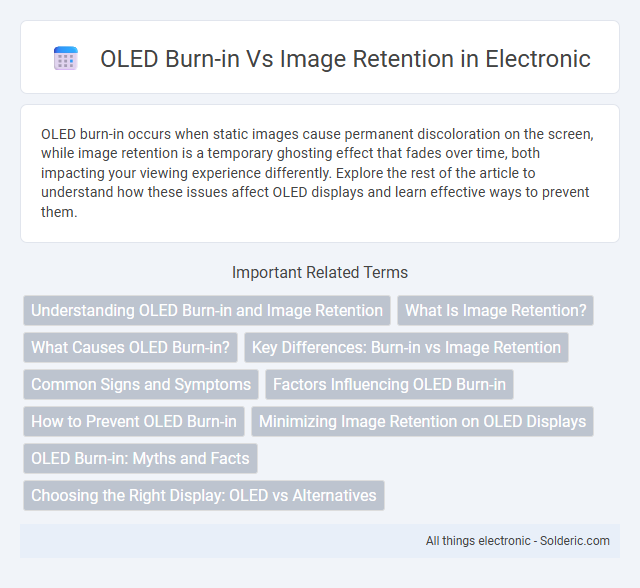OLED burn-in occurs when static images cause permanent discoloration on the screen, while image retention is a temporary ghosting effect that fades over time, both impacting your viewing experience differently. Explore the rest of the article to understand how these issues affect OLED displays and learn effective ways to prevent them.
Comparison Table
| Aspect | OLED Burn-in | Image Retention |
|---|---|---|
| Definition | Permanent pixel damage causing ghost images | Temporary ghost images from static content |
| Cause | Prolonged display of static images with high brightness | Short-term display of static images |
| Duration | Permanent and irreversible | Temporary; disappears after use of dynamic content |
| Visibility | Persistent visible artifacts | Usually faint and transient |
| Prevention | Use screen savers, lower brightness, avoid static images | Avoid long static content; auto brightness adjustment |
| Impact on Warranty | Often not covered, as it is considered user-induced | Generally not an issue; considered normal behavior |
Understanding OLED Burn-in and Image Retention
OLED burn-in occurs when static images are displayed for prolonged periods, causing permanent discoloration due to uneven pixel aging. Image retention is a temporary effect where ghost images remain visible but typically fade with time or screen changes. Understanding the difference helps you take steps to minimize damage and prolong your OLED display's lifespan.
What Is Image Retention?
Image retention refers to a temporary phenomenon where a faint ghost of a previous image remains visible on an OLED screen after the content has changed. This occurs when certain pixels are overused and retain a residual charge but typically disappears after displaying varied content or turning off the screen. Understanding image retention is crucial for prolonging your OLED display's lifespan and distinguishing it from permanent burn-in damage.
What Causes OLED Burn-in?
OLED burn-in occurs when static images are displayed for prolonged periods, causing uneven wear on the organic light-emitting diodes and resulting in permanent ghost images. High brightness settings and displaying high-contrast content accelerate the degradation of specific pixels, intensifying burn-in risks. You can minimize damage by varying content and adjusting screen brightness to prevent uneven pixel aging.
Key Differences: Burn-in vs Image Retention
OLED burn-in occurs when static images cause permanent pixel damage, leading to ghosting that cannot be reversed, whereas image retention is a temporary discoloration that fades over time with varied content. Burn-in results from prolonged display of high-contrast elements, while image retention typically appears after short-term usage and disappears with normal screen activity. Understanding these distinctions helps you manage OLED screen longevity and avoid permanent damage.
Common Signs and Symptoms
OLED burn-in and image retention both manifest through persistent visuals on your screen, but with distinct characteristics. Common signs of OLED burn-in include permanent ghost images or discoloration that remain visible even when the content changes. In contrast, image retention tends to be temporary, appearing as faint afterimages or shadows that typically disappear after displaying different content or resting the screen.
Factors Influencing OLED Burn-in
OLED burn-in is primarily influenced by factors such as prolonged display of static images, high brightness settings, and uneven pixel usage, which accelerate organic material degradation. Variations in content, usage patterns, and device calibration also play critical roles in the onset and severity of burn-in. Understanding these factors enables better management of OLED lifespan and image quality.
How to Prevent OLED Burn-in
Prevent OLED burn-in by regularly adjusting screen brightness and enabling screen savers or pixel shift features to minimize static image display. Use dark mode settings and avoid displaying the same high-contrast content for extended periods to reduce uneven pixel wear. Regularly updating software with manufacturer optimizations also helps maintain OLED panel longevity and prevent permanent image retention.
Minimizing Image Retention on OLED Displays
Minimizing image retention on OLED displays involves managing static content and varying visuals regularly to prevent prolonged pixel stress. You can reduce the risk by adjusting screen brightness and enabling features like pixel shift or screen savers designed to move images subtly. Proper usage habits, combined with software tools, help maintain your OLED's longevity and visual quality.
OLED Burn-in: Myths and Facts
OLED burn-in is often misunderstood as permanent damage when it actually results from uneven pixel wear over time, causing ghost images to persist on your screen. Unlike temporary image retention, which fades after a short period, true burn-in is a lasting effect that typically arises from static elements displayed for prolonged periods. Managing brightness settings and varying screen content can significantly reduce the risk of OLED burn-in, debunking myths that it is unavoidable or solely a product defect.
Choosing the Right Display: OLED vs Alternatives
OLED burn-in occurs when static images cause permanent pixel damage, while image retention is a temporary ghosting effect that fades over time. Compared to LCD or LED displays, OLED panels offer superior contrast and color accuracy but require careful content management to avoid burn-in. When choosing the right display, consider usage patterns--OLED excels in dark environments with dynamic content, whereas alternatives like LCDs are better for static or high-brightness needs without burn-in risk.
OLED Burn-in vs Image Retention Infographic

 solderic.com
solderic.com